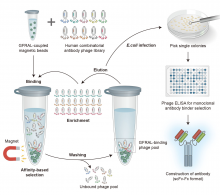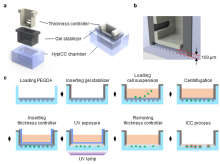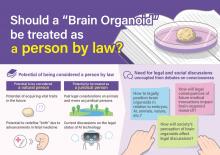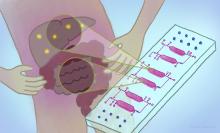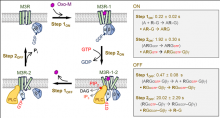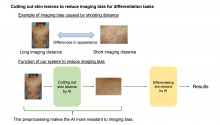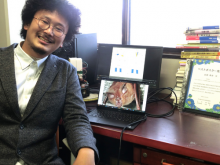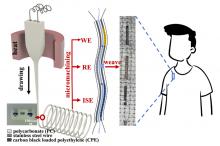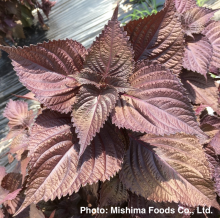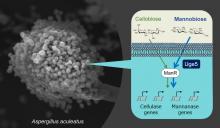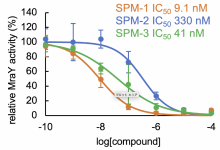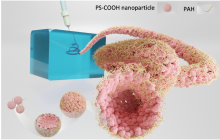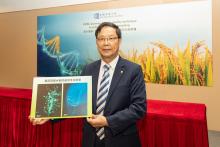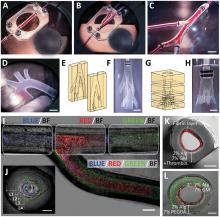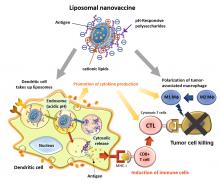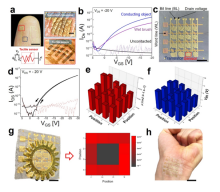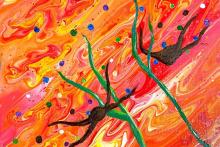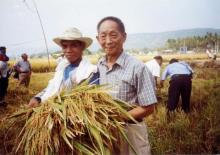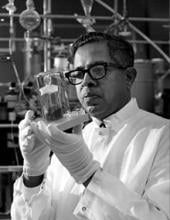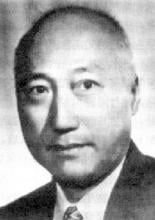Biotech
News
11 May 2023
- In a groundbreaking study, Professor Yea’s DGIST research
team verified the effectiveness of the anti-GFRAL human
antibodies in improving chemotherapy-induced cancer cachexia
- The team presents a candidate antibody for managing cancer cachexia, a condition without an approved and effective
therapy worldwide
11 May 2023
- The DGIST team of Professor Minseok Kim is jointly developing a platform that can analyze rare cells without loss with CTCELLS, Inc.
- A high cell preservation rate and reproducibility have been achieved as well as accurate immunocytochemistry technology implementation.
- Research results have been published in ACS Applied Materials & Interfaces.
05 May 2023
Asia Research News monitors the latest research news in Asia. Some highlights that caught our attention this week are a natural glue to hold stem cells in place, how cancer manipulates our immune cells, and the answer to Everest’s spooky nighttime noises.
28 Apr 2023
Asia Research News monitors the latest research news in Asia. Some highlights that caught our attention this week are a flu that could potentially jump from dogs to humans, a surgically-implanted chip that can help with serious addiction cravings, and a powerful jet emitted from a supermassive black hole.
28 Apr 2023
Researchers discuss whether a "brain organoid" should be treated as a person by law, and suggest the need for legal and social discussions uncoupled from debates on consciousness.
21 Apr 2023
Asia Research News monitors the latest research news in Asia. Some highlights that caught our attention this week are bioprinting organs and tissues, settling a debate on a monster, and shedding light on dark matter.
10 Apr 2023
Nitrogen is such a crucial nutrient for plants that vast quantities of nitrogen-containing fertilizers are spread on farmlands worldwide. However, excess nitrogen in the soil and in drainage run-off into lakes and rivers causes serious ecological imbalances. A recent study has uncovered the regulatory mechanisms at work when plants utilize nitrogenous fertilizers in their roots, a positive step in the quest to generate crops that require less fertilizer while still producing the yields needed to feed the world.
07 Apr 2023
A tiny platform empowers scientists to examine how gut and liver cells interact in health and disease.
31 Mar 2023
- The effect of the cycle of G proteins in real time on the two-step structural change of cell membrane receptors has been investigated
- This study is expected to be applied to pathologies related to G protein-coupled receptors and on research for their treatments
31 Mar 2023
- DGIST Professor Minseok Kim’s research team has developed an electronic medicine that can restore normal Schwann cell phenotypes in CMT disease models
- It presents the potential of electric stimulation-based treatment for chronic peripheral nerve disorders
16 Mar 2023
Annual innovation event brings together global innovators, entrepreneurs, researchers and scientists, and experts from various fields and industries to showcase their latest innovations, share ideas, and collaborate with industries to develop better technologies and solutions to shape our future. This is also a platform for innovators to meet potential investors and partners.
14 Mar 2023
Atopic dermatitis skin lesions and the lesions produced by infectious complications of the disease look so similar that it makes it impossible for patients to spot the difference and know when to visit their doctor for treatment. But an AI-powered mobile app developed by dermatologists now puts the power of diagnosis in the hands of patients.

14 Mar 2023
In a study recently published in the journal ACS Nano, published by American Chemical Society, researchers from Kanazawa University, Kanazawa, Japan, collaborating with University of Washington, Seattle, USA, used frequency modulated atomic force microscopy to reveal the molecular architecture of a genetically designed peptide and its self-organization that forms single-molecule thick crystals on atomically flat graphite surfaces, that offer a potential platform for hybrid technologies such as bioelectronics, biosensors, and protein arrays.
04 Mar 2023
Scientists have shown that swarming molecular robots can deliver cargo five times more efficiently than a robot working on its own.
03 Mar 2023
Researchers are working to overcome challenges in order to bring wearable, electric, wound-healing devices to clinical practice.
02 Mar 2023
Bioengineers formulated a mathematical model that clarified the importance of bat ear motions in direction detection, making way for lean, mean sonar navigation machines.
19 Jan 2023
Imagine if your t-shirt could take your sweat and analyze it for health abnormalities. Well, this is much closer to reality after a recent breakthrough by a research group led by a Tohoku University assistant professor. The group created the first microelectronic fiber with microscopic parameters that is capable of analyzing electrolytes and metabolites in sweat.
11 Jan 2023
A team of Japanese researchers created a high-quality genome assembly of red perilla, a step toward harnessing the plant’s potentially useful bioactive chemicals — and its medicinal properties.
10 Jan 2023
An Osaka Metropolitan University research team analyzed the regulatory mechanisms of carbohydrate-hydrolyzing enzyme production in Aspergillus aculeatus, a filamentous fungus that produces enzymes with an excellent ability to degrade plant biomass. The team found that UDP-glucose 4-epimerase (Uge5), an enzyme known for its involvement in galactose metabolism, also regulates the expression of degrading enzyme genes in A. aculeatus. This is the very first report of Uge5’s roles in selective gene expression in response to different types of inducing sugars in filamentous fungi.
20 Dec 2022
Researchers have designed and synthesized analogs of a new antibiotic that is effective against multidrug-resistant bacteria, opening a new front in the fight against these infections.
15 Dec 2022
A research team led by the University of Hong Kong (HKU) and Lawrence Berkeley National Laboratory has invented an all-water robotic system that resolves the constraints of bio-inspired robots through revolutionary scientific advances.
14 Dec 2022
- Discovery of potential treatment target networks for gene dysregulation uniquely found in patients with autism spectrum disorder
- Published in ‘Molecular Psychiatry,’ an international journal of molecular psychiatry
12 Dec 2022
Revelations about the mechanisms of two key proteins which maintain the asymmetric distribution of cholesterol within the cell membrane could help understand and treat diseases linked to its imbalance
01 Dec 2022
Research led by Hong Kong Baptist University (HKBU) involving the use of a pioneering female sterility technique has led to a breakthrough in the production of hybrid rice seeds. Compared to the commonly used “three-line” male sterility technique in hybrid rice seeds production, the novel approach enhances the efficiency of hybrid rice production by eliminating rice seeds that have been produced due to the self-pollination of the “restorer line”. The novel technique enables fully automatic harvesting of hybrid seeds by machines, which can substantially reduce harvesting costs.
11 Nov 2022
Asia Research News monitors the latest research news in Asia. Some highlights that caught our attention this week are a bioinspired tiny jumping robot, evidence of gender stereotypes in young children, and the first sighting of a new species of crab.
02 Nov 2022
The biofabricated vascular models will pave the way for drug development and deeper understanding of cardiovascular diseases.
31 Oct 2022
A research group at Osaka Metropolitan University has developed a drug delivery system that activates a strong cellular immune response to attack cancer cells, using one-tenth of the amount of antigen needed in the group’s previous work. By incorporating positively charged cationic lipids into liposomes and adding negatively charged pH-responsive polysaccharides to the surface, the research group increased the uptake efficiency of liposomes encapsulating cancer antigens by dendritic cells by approximately five times, which increased cytokine production by about 100 times. This increased M1-type macrophages, which activate cancer immunity, and decreased M2-type macrophages, which promote cancer growth.
25 Oct 2022
Small neighboring galaxy filled with dark matter detected with gamma rays, How a virus induces heart inflammation, Shedding light on the happy hormone, Microfossils may hold key evolution clues. Read all in the October's Editor's Choice plus Upcoming event KNOWLEDGE MARKETPLACE – Bangkok 2022: Exchanging of ideas for a Democratic Myanmar.
27 Sep 2022
- A research team led by Professor Lee Sungwon from DGIST succeeded in developing the world’s first mesh (nanomesh) structured electronic skin device (organic field-effect transistor)
- An electronic skin device comprising only a mesh (nanomesh) structure that can measure and process bio-signals for a prolonged period indicates a big step toward integrated systems for electronic skin devices.
20 Sep 2022
A research group led by the Institute of Industrial Science, The University of Tokyo, finds that sensory neurons in human skin modulate melanocytes via the secretion of Repulsive Guidance Molecule B
Events
Sorry, no events coming up for this topic.
Researchers
Sorry, no researchers coming up for this topic.
Giants in history
Pakistani botanist Azra Quraishi (22 September 1945 – 22 November 2002) is recognised for developing virus-free seed potatoes that increased potato production in Pakistan by an estimated five per cent.
Indian botanist Shipra Guha-Mukherjee (13 July 1938 – 15 September 2007) made a breakthrough discovery that enabled the genetic study of plants and, by extension, the development of improved varieties of rice, wheat, potatoes, and other crops.
Japanese chemist Takamine Jokichi (3 November 1854 – 22 July 1922) founded the Tokyo Artificial Fertilizer Company, where he isolated a starch-digesting enzyme (named takadiastase) from the fungus Aspergillus oryzae.
Filipina chemist María Orosa (29 November 1892–13 February 1945) fought malnutrition and food insecurity in the Philippines by devising over 700 culinary creations including Soyalac, a nutrient rich drink made from soybeans, and Darak, rice cookies packed with Vitamin B1, which could prevent beriberi disease caused by Vitamin B1 deficiency. She was also a partisan of the guerrilla movement resisting Japanese occupation during World War II, and died after being struck by shrapnel while working in her laboratory during the Battle of Manila.
Chinese biochemist Cao Tianqin (5 December 1920 – 8 January 1995) discovered the myosin light chain, a subunit of myosin, a protein crucial for muscle contraction.
In 1939, biochemist Kamala Sohonie (18 June 1911 – 28 June 1998) became the first woman to be accepted into the Indian Institute of Science (IISc).
Chinese agronomist Yuan Longping (7 September 1930 – 22 May 2021) developed the first varieties of the high-yield, hybrid rice that brought food security to multiple countries including China, which had been ravaged by food shortages as recently as the mid-20th century.
David T. Wong (born 1936) is a Hong Kong-born American neuroscientist who is best known for discovering the antidepressant drug fluoxetine, better known as Prozac.
Cyril Andrew Ponnamperuma (16 October 1923 – 20 December 1994) was a Sri Lankan chemist who was interested in the origins of life on Earth. His research in chemical evolution showed how inanimate molecules may have given rise to the building blocks of life – a process known as abiogenesis.
Osamu Shimomura (27 August 1928 – 19 October 2018) was a Japanese organic chemist and marine biologist who dedicated his career to understanding how organisms emitted light.
Janaki Ammal Edavalath Kakkat (4 November 1897 – 7 February 1984) was an Indian botanist who studied plant chromosomes and genetics.
Gopalasamudram Narayanan Ramachandran (8 October 1922 – 7 April 2001) is best known for developing the Ramachandran plot to understand the structure of short chains of amino acids, known as peptides.
Hsien Wu (24 November 1893 – 8 August 1959) is widely regarded as the founder of biochemistry and nutrition science in China. He was the first to propose that protein denaturation was caused by the unfolding of the protein, instead of chemical alteration.
Umetaro Suzuki (7 April 1874 – 20 September 1943) was a Japanese scientist best remembered for his research on beriberi, a disease caused by vitamin B1 deficiency, characterized by limb stiffness, paralysis and pain.
Maqsudul Alam (14 December 1954 – 20 December 2014) was a biologist from Bangladesh who is renowned for his research on genome sequencing
Barry Paw (29 August 1962 – 28 December 2017) was a biologist and oncologist who discovered several novel genes and their functions in red blood cells.
Gloria Lim (1930-2022) was a mycologist from Singapore who studied tropical fungi. One of the first students to attend University of Malaya when it was founded in 1949, she went on to become the first female Dean of the Faculty of Science at the University of Singapore.


